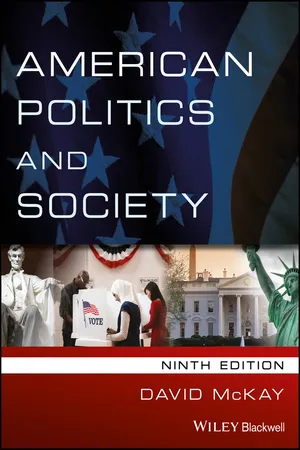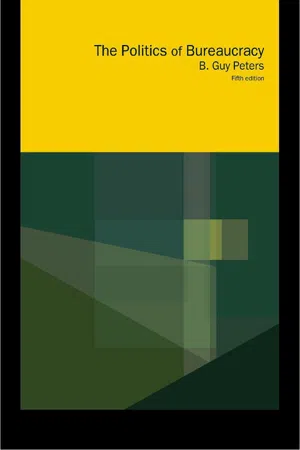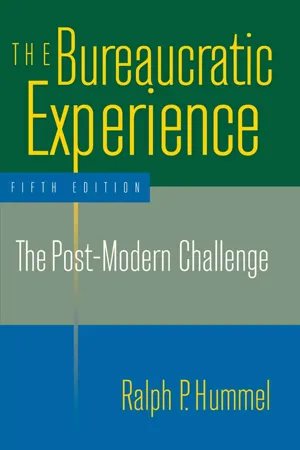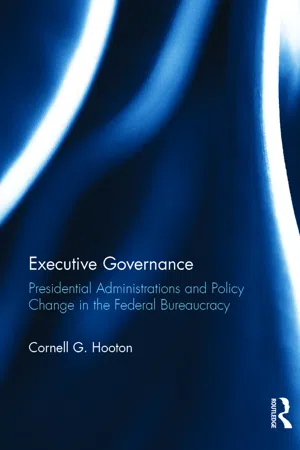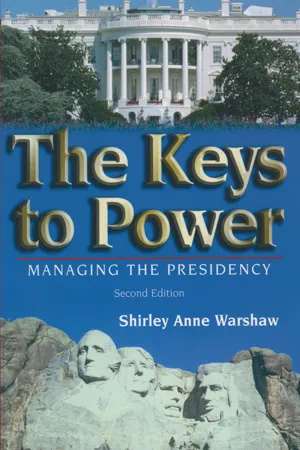Politics & International Relations
Federal Bureaucracy
The federal bureaucracy refers to the administrative organization of the executive branch of the government, responsible for implementing and enforcing laws and policies. It includes various departments, agencies, and employees who carry out specific functions such as regulating industries, providing public services, and managing government programs. The federal bureaucracy plays a crucial role in the functioning of the government and the delivery of public services.
Written by Perlego with AI-assistance
Related key terms
6 Key excerpts on "Federal Bureaucracy"
- eBook - ePub
US Foreign Policy in Action
An Innovative Teaching Text
- Jeffrey S. Lantis(Author)
- 2012(Publication Date)
- Wiley-Blackwell(Publisher)
For the purposes of this study, foreign policy bureaucracies are defined as executive branch organizations or agencies with a profound influence on US relations with the world. These organizations play a role in the day-to-day operations of any government; they represent the networks of professionals and institutions that make any large organization tick. Once you begin thinking about the presence of bureaucracies, you can see evidence of them everywhere. The college or university you are attending is run by a bureaucracy (perhaps headed by a president, chancellor, or provost), and the state in which you reside is administered by a governor and scores of departments and offices.This approach adopts a bureaucratic politics frame – examining the policy process as an extension of the role of individuals, groups, and organizations in shaping policy. The federal government is, in many ways, a large and complicated network of bureaucracies that manages domestic and foreign policy. It is important to remember several things about these organizations. While some associate the term bureaucracy with complicated processes, or “red tape,” these agencies are also the key to effective functioning of any large organization. Even though they are not elected, officials at different levels of bureaucracies make policy decisions that impact the lives of citizens and non-citizens every day. Thus, focusing on bureaucracies as key players in the process requires adopting a distinct theoretical approach. - eBook - ePub
- David McKay(Author)
- 2017(Publication Date)
- Wiley-Blackwell(Publisher)
Chapter 12 Bureaucratic Power Federal Departments and AgenciesOutline
- The Federal Bureaucracy: Organization and Function
- Controversy 11. Privatization: For and Against
- The Bureaucracy: How Uncontrollable?
- The Inherent Power of Bureaucracy
- The Bureaucratic Hydra: A Uniquely American Phenomenon?
- Reform Attempts
- Concluding Remarks
- Summary
- Questions for Discussion
- Glossary
- Notes
- Further Reading
The fully developed bureaucratic mechanism compares with other organizations exactly as does the machine with the non-mechanical modes of production. Precision, speed, unambiguity, knowledge of the files, continuity, discretion, unity, strict subordination, reduction of friction and of material and personal costs: these are raised to the optimum point in the strictly bureaucratic administration.– MAX WEBER, ESSAYS IN SOCIOLOGYOur Government has no special power except that granted it by the people. It is time to check and reverse the growth of government which shows signs of having grown beyond the consent of the governed. It is my intention to curb the size and influence of the federal establishment.– RONALD REAGANFew areas of federal government activity come in for as much opprobrium as does the bureaucracy. As the Weber quote suggests, bureaucracies are supposed to work efficiently. Hierarchy, order, responsibility and professionalism are implied by the model of the ‘rational’ bureaucrat, yet, according to public folklore, typical federal administrators are the very opposite of this. They are overpaid, inefficient and wasteful. Worse, they are often the creatures of special interests, and occasionally they are simply corrupt. Surveys have shown, indeed, that the federal government is considered easily the most inefficient of all the major institutions in American society. And the public’s regard for the federal government steadily declined after reaching a peak in the wake of 9/11 (figure 12.1 ).Figure 12.1 - eBook - ePub
- B. Guy Peters, Guy Peters(Authors)
- 2002(Publication Date)
- Routledge(Publisher)
3 We would not expect political institutions to abdicate their rights to bureaucrats, nor do we expect a declaration of bureaucratic government to emanate from the depths of some office building in Foggy Bottom, Whitehall, or Karlavagen. Rather, we are interested in the degree to which – given the lack of leadership alleged to be besetting traditional institutions of government and the difficulties that even skilled leaders have in managing government departments – the bureaucracy is capable of providing needed direction and leadership. This has been largely assumed by theorists of postindustrial society; we now intend to provide some direction in conceptualization, measurement and analysis.Bureaucratic government
What must any group of actors in politics do to effectively govern a country? The root word for “government” implies control and steering; can any group really be said to be controlling the large and complex societies and economies of industrialized countries? Further, the increasing globalization of economic and social life places an additional constraint on the ability of those in government to govern. This has been true for Third World countries for some years, but it is also increasingly true for industrialized economies.4 - eBook - ePub
The Bureaucratic Experience: The Post-Modern Challenge
The Post-Modern Challenge
- Ralph P. Hummel(Author)
- 2014(Publication Date)
- Routledge(Publisher)
The secret of bureaucrats’ power lies in the fact that they are given time and space to develop their specialization and expertise. (No term limits!) Since this is true both for corporate bureaucrats and government bureaucrats, this puts lawmakers at a disadvantage. But the key to power may be bureaucracy’s ability to function as a transformer of substantive human needs into satisfactions that act as surrogate answers to such needs but are actually far removed from the substance expected. Thus the demand for justice is answered by law, for peace by readiness for war, for help in doing well in society by welfare, for getting a job at a livable wage by workfare, for health by diagnostic related groups, for security by rigidity.Bureaucrats themselves may not understand the destructive impact such solutions have on politics. Or such solutions, of which they are masters, may feed their natural antagonism toward their nominal masters.Playing on modern human beings’ search for stability and security, bureaucrats tend to attack politics. A federal bureaucrat:We draw up good legislation in the national interest with all the parts fitting into the whole properly, and what happens to it when it hits the [Capitol] Hill is like a Christian among the heathen.… So we spend lots of time figuring out how we can do something we want to do and think we should do, without taking a new piece of legislation over to Congress. (From a rare survey of high-level federal bureaucrats, cited in Green, 1984: 185)Apart from the use of engineering models in which all the parts neatly fit the whole, bureaucrats also tend to treat political issues as technical issues: matters for scientific research that will uncover the “facts” just waiting out there to be discovered.Another federal bureaucrat:Yet there is this third possibility: Bureaucrats are superior in being in touch with full modernity, while politicians live in the backwaters of modernity.The bureaucrat has a program to carry out that he believes in. The question of whether or not Congress has authorized it is not so important to him. He figures that if Congress really had the facts and knew what was right, it would agree with him. (Ibid.)Lawmakers as Bureaucrats
Lawmakers themselves are seduced into accepting the bureaucratic approach, viewing politics as technical issues to be decided according to technical (problem-solving) rather than political (problem-shaping) standards. For example, a political scientist studying the increased use of staff and reliance on experts by members of Congress observed: “Overburdened and somewhat intimidated by the material the experts throw at them, they [Congressmen] are delighted when issues can be resolved in apparently noncontroversial, technocratic terms” (Malbin, 1980: 243–44). - eBook - ePub
Executive Governance: Presidential Administrations and Policy Change in the Federal Bureaucracy
Presidential Administrations and Policy Change in the Federal Bureaucracy
- Cornell G. Hooton(Author)
- 2019(Publication Date)
- Routledge(Publisher)
This study argues that many of the difficulties of changing practice are attributable not simply or even primarily to the personal dispositions of career officials but rather to the normal characteristics of organizational behavior, as embodied and compounded by the particular institutional framework and political context of the departmental bureau. The preferences, calculations, and political resources of top-level policy-makers play a role in change—as do the limited administrative resources and formal organizational structures of a bureau—but to focus solely on one or another of these misses significant facets of policy change. A focus on just the “bureaucratic politics” of the explicit calculations and actions among top-level political and career executives overlooks the “natural,” bottom-up difficulties that policy adaptation and maintenance entail. The existing training, expertises, and task orientations within a bureau favor certain policy options and slow the adoption of others (see also Weaver 1977; Katzmann 1980; Eisner 1991)—and constitute biases that the personal preferences of career officials can compound. When careerists in key offices disapprove of a particular policy option, their (in)action can reinforce the difficulties of defining and coordinating action by failing to supply the voluntary efforts that help translate top-down policy preference into pragmatic details of understanding, agreement, and dedicated resources. These biases are, though, unavoidable in the establishment and coordination of complex organizational systems of career officials who are physically widely distributed among the pertinent bureau offices and who as individuals are relatively narrowly concerned with segmented day-to-day activities that are only loosely coordinated across those offices. These people must somehow coordinate their conceptions and tasks to embody new policies as practical endeavors. Simultaneously, the federal policy-making context has direct and indirect influences that slow or stymie administrative implementation. The context often encourages career officials to stress formal and legal considerations. External actors can adjust the flow of necessary input factors (e.g., money, authority, research efforts, project applications; see Moe 1985a) and occupy a place in the strategic anticipation of those career officials who are aware of the likely relevant actions of external actors. Nonetheless, the political executives in charge of a bureau are in the most immediately advantageous positions organizationally and institutionally to define, implement, and institute their policy preferences as durable bureaucratic activities, as a variety of studies are beginning to show (e.g., Wood and Waterman 1991; Sabatier, Loomis, and McCarty 1995), albeit within the bound of extant law and administrative resources.In short, political executives face a range of tasks and potential problems when they seek policy change. Executives must not only select policy priorities but also determine the appropriateness of the relevant alternatives to their administrative, policy, and political environments; some policy alternatives are better suited than others regarding not just the policy and political environments but also the existing expertises, training, and predispositions within the relevant bureaus themselves. While observers of bureaucracy have often recognized the parts of extant administrative resources (labor, money, legal authority), formal organizational structures (divisions of labor, span of control, lines of hierarchy), and external political support (cooperation, compliance), the conceptual components of cognition, preference, and perception have not yet received much attention, although they are increasingly the focus of attention not just among students of bureaucracy but also among students of the policy process (Sabatier 1988; March and Olsen 1989; Baumgartner and Jones 1991). To be successful, appointees need to recognize the capabilities and conceptions that hold in their organizations and determine the efforts that their policy preferences require to change those conceptions. While “macro”-level efforts at structural change are appropriate, “micro’Mevel methods will often suffice. Such internal matters require time and energy from the bureau chief, but they also change the basis for bureaucratic performance more extensively and durably than would otherwise be the case—and thereby constrain the subsequent bureau chief and others who would change policy again. - eBook - ePub
The Keys to Power
Managing the Presidency
- Shirley Anne Warshaw(Author)
- 2015(Publication Date)
- Routledge(Publisher)
© Ron Sachs/CNP/Sygma/Corbischapter ten
The President and the BureaucracyA s the nation has grown both in geographic size and in population, the responsibilities of the national government have grown concurrently. The roles and responsibilities of the government have grown to encompass more than 1,400 different programs, housed in 15 executive agencies, and a myriad of independent agencies and regulatory commissions, which employ 2,700,000 federal employees and have a budget of over $1.7 trillion. This explosion in the responsibilities of the national government has led to a proliferation of the bureaucracy. The relationship between the president and the bureaucracy has often been difficult, as presidents endeavor to move their programs through an often intransigent federal workforce. This has become a significant problem for presidents, who often see the departmental bureaucracies slowing down federal programs or moving programs in directions that are not in line with presidential goals and objectives.Modern presidents have had to deal with a rapidly burgeoning bureaucracy. During the 1960s and 1970s, a host of new agencies emerged, both large departments and smaller agencies and commissions. In general, the new departments were among the largest in the federal structure. The Department of Housing and Urban Development and the Department of Transportation, established respectively in 1965 and 1966, and the Departments of Energy and the Department of Education, established respectively in 1977 and 1979, became significant parts of the Federal Bureaucracy. The environmental movement led to creation by executive order in 1970 of the Environmental Protection Agency and of the Consumer Product Safety Commission in 1972. Only in the past half-century have presidents had both the benefits and the problems of a diverse, politically powerful, and extremely large Federal Bureaucracy.
Learn about this page
Index pages curate the most relevant extracts from our library of academic textbooks. They’ve been created using an in-house natural language model (NLM), each adding context and meaning to key research topics.

